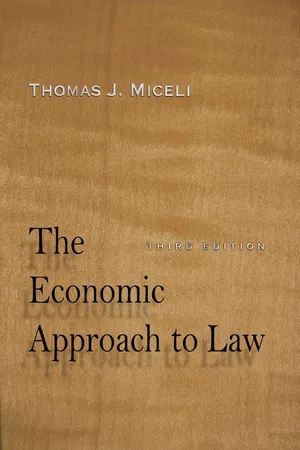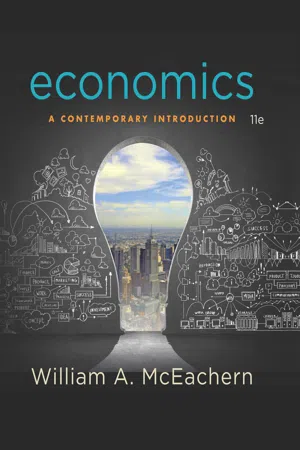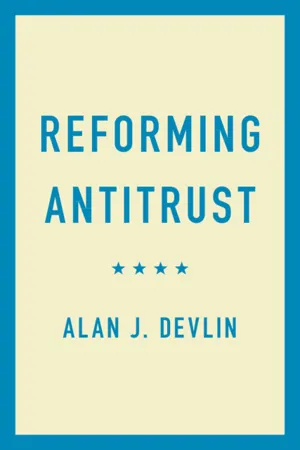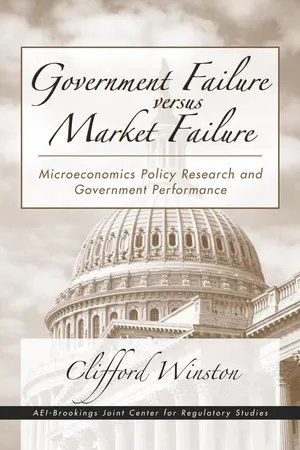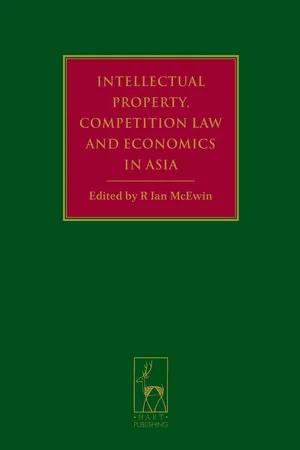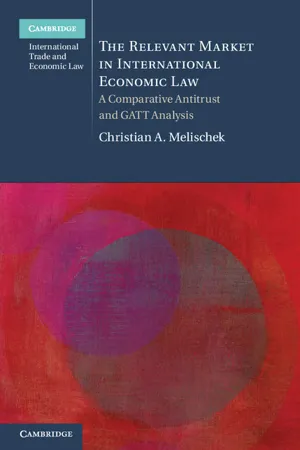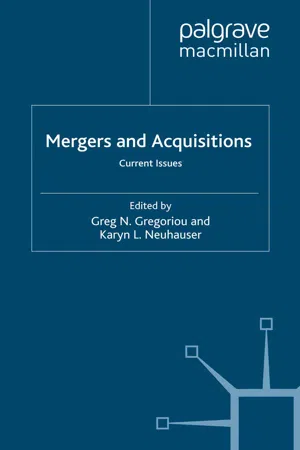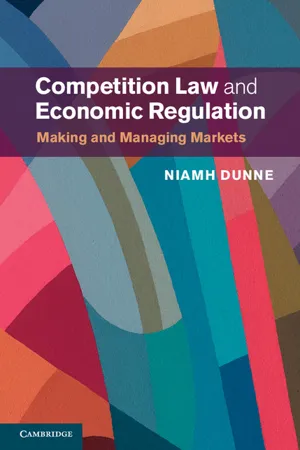Economics
Antitrust Law
Antitrust law refers to legislation designed to promote fair competition and prevent monopolistic practices in the marketplace. It aims to protect consumers by prohibiting activities such as price-fixing, bid-rigging, and other anti-competitive behaviors. Antitrust laws are enforced by government agencies to ensure that businesses operate within the boundaries of fair competition.
Written by Perlego with AI-assistance
Related key terms
1 of 5
12 Key excerpts on "Antitrust Law"
- eBook - ePub
- Thomas J. Miceli(Author)
- 2017(Publication Date)
- Stanford Economics and Finance(Publisher)
CHAPTER 10 THE ECONOMICS OF Antitrust LawThis chapter examines the economic justification for Antitrust Laws, the body of statutes and judicial rulings whose objective is to prevent anticompetitive business practices. Economists have long contributed to this area of law, leading many to label it as the “old” law and economics (as opposed to the “new” law and economics, which refers to the economic study of areas of law not explicitly concerned with markets—that is, the subject of the previous nine chapters of this book). Antitrust nevertheless remains a vigorous subfield of law and economics. This is true because, unlike many areas of law studied by economists, economic theory has much to contribute to our understanding of the efficient operation of markets.Of course, the starting point for any investigation of market regulation must be the Invisible Hand Theorem, which says that competitive markets, if left unregulated, will achieve an efficient allocation of resources. While this may suggest a laissez-faire attitude toward regulation, the conditions for perfect competition are rarely if ever met in practice. Thus, when significant departures from competition exist, whether through the efforts of a single firm, or a group of firms acting in concert, to exercise monopoly power, the resulting misallocation of resources may justify government intervention. This is the economic rationale for Antitrust Law.The literature on antitrust is vast, so this chapter offers only an overview of some of the key issues, with an emphasis on the insights economic theory can offer. We begin with a review of the economics of perfect competition, which provides a benchmark for measuring the efficiency losses due to monopoly. We then turn to the role of the law in promoting competition.1 Perfect Competition Versus MonopolyA monopoly - eBook - PDF
Microeconomics
A Contemporary Introduction
- William A. McEachern(Author)
- 2016(Publication Date)
- Cengage Learning EMEA(Publisher)
4. Antitrust Laws are aimed at promoting competition and prohibit-ing efforts to cartelize, or monopolize, an industry. The Sherman, Clayton, and FTC acts provide the legal and institutional frame-work for antitrust enforcement, a framework that subsequent amendments and court cases have clarified and embellished. 5. The courts have interpreted Antitrust Laws in two ways. Some practices have been found to be illegal per se—that is, regardless of the economic rationale or consequences. Other decisions have been based on the rule of reason, meaning the courts weigh why the off-ending practice was adopted and what effect it has on competition. 6. Competition in U.S. industries has been increasing since World War II. Four sources of increased competition are greater interna-tional trade, deregulation, antitrust policy, and technological change. Key Concepts Market power 335 Social regulation 336 Economic regulation 336 Antitrust policy 336 Public utilities 338 Capture theory of regulation 341 Trust 342 Sherman Antitrust Act of 1890 342 Clayton Act of 1914 342 Tying contract 342 Exclusive dealing 342 Interlocking directorate 342 Federal Trade Commission (FTC) Act of 1914 342 Horizontal merger 342 Vertical merger 342 Consent decree 343 Per se illegal 343 Rule of reason 343 Predatory pricing 343 Herfindahl–Hirschman Index, or HHI 344 Conglomerate merger 346 Questions for Review 1. Business Behavior and Public Policy Define market power, and then discuss the rationale for government regulation of firms with market power. 2. Government Regulation What three types of government policies are used to alter or control firm behavior? Determine which type of regulation is used for each of the following: a. Preventing a merger that the government believes would lessen competition b. The activities of the Food and Drug Administration c. Regulation of fares charged by a municipal bus company d. - eBook - PDF
Economics
A Contemporary Introduction
- William A. McEachern(Author)
- 2016(Publication Date)
- Cengage Learning EMEA(Publisher)
4. Antitrust Laws are aimed at promoting competition and prohibit- ing efforts to cartelize, or monopolize, an industry. The Sherman, Clayton, and FTC acts provide the legal and institutional frame- work for antitrust enforcement, a framework that subsequent amendments and court cases have clarified and embellished. 5. The courts have interpreted Antitrust Laws in two ways. Some practices have been found to be illegal per se—that is, regardless of the economic rationale or consequences. Other decisions have been based on the rule of reason, meaning the courts weigh why the off- ending practice was adopted and what effect it has on competition. 6. Competition in U.S. industries has been increasing since World War II. Four sources of increased competition are greater interna- tional trade, deregulation, antitrust policy, and technological change. Key Concepts Market power 335 Social regulation 336 Economic regulation 336 Antitrust policy 336 Public utilities 338 Capture theory of regulation 341 Trust 342 Sherman Antitrust Act of 1890 342 Clayton Act of 1914 342 Tying contract 342 Exclusive dealing 342 Interlocking directorate 342 Federal Trade Commission (FTC) Act of 1914 342 Horizontal merger 342 Vertical merger 342 Consent decree 343 Per se illegal 343 Rule of reason 343 Predatory pricing 343 Herfindahl–Hirschman Index, or HHI 344 Conglomerate merger 346 Questions for Review 1. Business Behavior and Public Policy Define market power, and then discuss the rationale for government regulation of firms with market power. 2. Government Regulation What three types of government policies are used to alter or control firm behavior? Determine which type of regulation is used for each of the following: a. Preventing a merger that the government believes would lessen competition b. The activities of the Food and Drug Administration c. Regulation of fares charged by a municipal bus company d. - eBook - PDF
Securing Compliance
A Principled Approach
- Karen Yeung(Author)
- 2004(Publication Date)
- Hart Publishing(Publisher)
A central theme pervading the early decades of US antitrust was freedom of economic opportunity, and a particular concern for the protection of small busi-ness from the superior economic power of large enterprise. It was not until the late 1940s that the influence of economic analysis began to emerge, and the con-ceptual basis of Antitrust Law shifted from political concerns relating to the power of large enterprise and the vulnerability of small business to the discipline of economic analysis and the pursuit of competition in order to secure economic efficiency. In particular, the influence of the so-called ‘Chicago School’ of eco-nomics began to take hold in the 1970s, reaching its zenith in the mid 1980s dur-ing the Reagan administration. 20 Those associated with the Chicago School emphasised that economic efficiency should be sole and exclusive concern of Antitrust Law, for by so doing consumer welfare would be maximised. 21 Thus, trade restrictions which were apparently restrictive could nonetheless have the overall effect of enhancing economic efficiency and thus to prohibit them would be harmful to consumer welfare. Increasingly sophisticated economic argu-ments began to predominate in antitrust disputes, and it is now the norm for economic argument to play a critical role in antitrust cases in the US. The history of modern competition law demonstrates that the collective goals of competition law and policy have shifted over time. Although originally con-ceived as providing a legal framework for protecting the freedom of individual consumers and small business from the influence of large enterprise, competition Competition Regulation and Non-Economic Goals 19 19 Ibid . 20 Amato (1997); Posner (1979a). 21 Bork (1978). law is now almost universally regarded as the primary legal mechanism for pre-serving and maintaining the competitive functioning of markets. - eBook - PDF
- Alan J. Devlin(Author)
- 2021(Publication Date)
- Cambridge University Press(Publisher)
Although such rules do not presently exist in the United States, they are an established part of most competition regimes around the world. Those looking to correct a perceived loss of competition in the economy – or to protect vulnerable consumers against excessive pricing – may favor expanding antitrust’s reach beyond preserving market constraints to condemn undesirable effects themselves. In practice, the closest that US Antitrust Law has come to this position is the FTC’s infrequent (and controversial) use of Section 5 to enjoin unfair methods of competition that do not violate the Sherman Act. Notably, in June 2019, the FTC’s two Democratic Commissioners issued a statement 5 Under the rule of reason, most circuits require a plaintiff to prove that there was a substantially less restrictive restraint than the challenged restriction (which has a legitimate procompetitive justification). Competition Law’s Role 19 exploring the possibility of using Section 5 “to challenge excessive, unjustified drug price increases.” 6 That remains a minority position, but a change of administration could elevate that view to policy. Finally, market skeptics may envision a larger policy role for the federal Antitrust Laws. Specifically, they may view antitrust as guarding against systematic threats flowing from the concentration of economic power, even if those dangers do not flow from lost competition. It is at this point that political values coalesce around antitrust policy. Competition laws may not simply preserve market-based constraints on the exercise of pricing power, but diffuse wealth and guard the democratic process against usurpation at the hands of those who secure outsized influence. The pervasive trusts of the late 1800s – and the various magnates who wielded undeniable power to effect industrial (and to a degree political) policy in the country – loom large on this account. - eBook - PDF
Government Failure versus Market Failure
Microeconomics Policy Research and Government Performance
- Clifford Winston(Author)
- 2007(Publication Date)
- Brookings Institution Press and AEI(Publisher)
prices above marginal cost is inversely related to consumers’ demand elas-ticities to minimize the welfare loss from inefficient substitution.) Although antitrust and economic regulation are motivated by different concerns, they share a common theme in that both seek to move a market closer to the competitive ideal. I therefore assess both in the same chapter. The theoretical justification for Antitrust Laws and economic regulation does not imply that government intervention is necessary to curb market power and improve economic efficiency—or that it has done so in practice. Nor is intervention warranted simply because one can cite examples of firms that have colluded or can identify markets that are subject to scale economies over a wide range of output. Policies to curb market power can be justified only by evidence that they can and do increase output and thereby raise social welfare. However, the summary findings that I draw from the current state of the available scholarly evidence are: Antitrust policies toward monopolization, mergers, and collusion have done little to raise consumer welfare, while economic regulation of agricultural products and international trade has produced large deadweight losses in the process of transferring resources from con-sumers to producers. Antitrust Policy U.S. antitrust policy is the responsibility of the Department of Justice (DOJ) and the Federal Trade Commission (FTC). The Justice Department enforces Section 1 of the Sherman Antitrust Act of 1890 prohibiting contracts, com-binations, and conspiracies in restraint of trade; Section 2 of the Sherman Act prohibiting actions to monopolize or attempts to monopolize markets through anticompetitive means; and, along with the FTC, Section 7 of the Clayton Act of 1914 (amended in 1950) prohibiting mergers between firms that threaten to lessen competition substantially in any line of commerce. - R Ian McEwin(Author)
- 2011(Publication Date)
- Hart Publishing(Publisher)
Congress appreciated that occasional higher costs and prices might result from the maintenance of fragmented industries and markets. It resolved these competing considerations in favor of decentralization. 36 In the 1960s, there came to the fore a generation of legal scholars who had learned, largely by collaboration with economists, to apply sound economic principles to Antitrust Law. Professors Phillip Areeda, Robert Bork, Ward Bowman, Richard Posner and others advo-cated an interpretation of the Antitrust Laws that promoted economic efficiency in the form of consumer welfare. A decade later the Supreme Court adopted economics as its tool of choice in interpreting the Antitrust Laws and since then has systematically revisited its old decisions ‘in order to bring [them] into alignment with the modern economic understand-ing of competition’ and industrial organisation. 37 For example, in the 1977 case Continental TV Inc v GTE Sylvania, Inc , 38 the Court held that non-price vertical restraints, such as a territorial restriction in a contract between a manufacturer and a retailer, would no longer be condemned as a per se violation of Sherman Act § 1, which prohibits any ‘contract com-bination or conspiracy in restraint of trade’; 39 henceforth they would be analysed under the ‘rule of reason’, 40 which entails a close examination and balancing of the likely pro- and 35 See Appalachian Coal v United States 288 US 344, 373–74 (1933) (characterising particular agreements among competitors as ‘stabiliz[ing] market prices’ and not ‘detrimental to fair competition’). 36 Brown Shoe Co v United States 370 US 294, 344 (1962). 37 Douglas H Ginsburg, ‘Originalism and Economic Analysis: Two Case Studies of Consistency and Coherence in Supreme Court Decision Making’ (2010) 33 Harvard Journal of Law and Public Policy 217, 218. 38 Continental TV Inc v GTE Sylvania, Inc 433 US 36 (1977).- eBook - PDF
The Relevant Market in International Economic Law
A Comparative Antitrust and GATT Analysis
- Christian A. Melischek(Author)
- 2012(Publication Date)
- Cambridge University Press(Publisher)
3 Market definition as an analytical tool in antitrust analysis The preceding section showed that market definition has been interpreted by the judiciary as a prerequisite to all major antitrust statutes. This, how- ever, does not explain the underlying logic for market definition. Its pur- pose as an analytical tool is outlined in the following. A Overview At the outset, it is important to realize that the fundamental question on the goals of antitrust policy has a direct bearing on the role of market definition. There are approaches to antitrust policy that reject market definition altogether as a decision-making tool. 24 As outlined above, and although the debate on the objectives of antitrust policy remains contro- versial, for present purposes it is an appropriate simplification to assume that the harmful efficiency and welfare effects of the economic power of firms, or “market power,” are the primary concern of antitrust policy. The meaning of the term “market power” is ambiguous and will be analyzed more closely below. Further obfuscating matters, different terminology, such as “dominance” (under Article 102 of the TFEU), “monopoly power” (under section 2 of the Sherman Act), and “market power” (under section 1 of the Sherman Act), is used in different provisions and jurisdictions, with more or less no precise distinction. In this study, the term “market power” is used as encompassing any concept of economic power of firms. The prohibition of monopolization or abuse of dominance is most evi- dently aimed at outlawing behavior driven by market power. Merger con- trol is also directed at preventing the concentration of excessive market 24 The concept of freedom of competition (“Konzept der Wettbewerbsfreiheit ”), intro- duced by Hoppmann, assumes that every product competes with every other in one unique and indivisible market: Hoppmann, Fusionskontrolle, pp. - eBook - PDF
Mergers and Acquisitions
Current Issues
- G. Gregoriou, Karyn Neuhauser(Authors)
- 2007(Publication Date)
- Palgrave Macmillan(Publisher)
155 10.1 INTRODUCTION The aim of this chapter is to survey the basic economic literature concern- ing the antitrust analysis of mergers in the USA. That is a relatively difficult task, since the USA has a long history of antitrust merger law, and it is also the country where the economic analysis of mergers began. The economic analysis of US antitrust merger law can be made using dif- ferent perspectives. In this chapter I shall adopt three of them, which seem to be representative of three important branches in the literature on law and eco- nomics. One of these perspectives is the theoretical literature on welfare eco- nomics, whose aim is to analyze the effect that different kinds of mergers may have on profits and surpluses generated in the markets where the merging companies operate. This literature is dominated by the analysis of a funda- mental trade-off that many mergers pose: the fact that they are able to gener- ate cost reductions in the merging partners but at the same time can affect the profits or surpluses of other economic agents that do not take part in the mergers, such as consumers, suppliers or competitors of the merging parties. A second line of analysis is the one followed by the literature that con- centrates on the economic logic of the statute and case law that governs mergers in the USA. Beginning with the introduction of mergers as a possi- ble anti-competitive practice in the Clayton Act (1914), mergers have been the main issue of two important Clayton Act amendments, introduced by the Celler–Kefauver Act (1950) and the Hart–Scott–Rodino Act (1976). All these C H A P T E R 1 0 The Economic Analysis of US Antitrust Merger Law Germán Coloma ECONOMIC ANALYSIS OF US ANTITRUST MERGER LAW 156 statutes have generated different economic interpretations of the require- ments that mergers have to fulfil to be considered anti-competitive, which materialized in a significant amount of case law concerning mergers. - eBook - PDF
Competition Law and Economic Regulation
Making and Managing Markets
- Niamh Dunne(Author)
- 2015(Publication Date)
- Cambridge University Press(Publisher)
Indeed, the urgency of any need for the adoption of ‘global’ standards in antitrust, over and above the elimination of actively harmful or counterproductive rules, has been questioned. 191 The increasing pervasiveness of economic analysis within competition law may none- theless provide a common analytical language of sorts across dozens of antitrust jurisdictions worldwide; assuming, of course, that economics can identify a single optimal answer to the legal question at issue. We have seen that systems of competition law typically address three broad categories of anticompetitive behaviour: concertation, unilateral conduct, and mergers. This book will focus on the first and second categories – what the European Commission, perhaps somewhat confus- ingly, describes as ‘antitrust’ rules as opposed to competition law more broadly. Mergers are largely excluded from our assessment, for several Commission, Guidelines on Vertical Restraints (OJ C130/1, 19.5.2010); see also Jones (2010). 183 European Commission, Guidance on the Commission’s enforcement priorities in applying Article 82 of the EC Treaty to abusive exclusionary conduct by dominant undertakings (OJ C45/7, 24.2.2009); see also Peeperkorn & Viertiö (2009); Monti (2010). 184 Case C-509/06 P GlaxoSmithKline, EU:C:2009:610, paras. 62–3. 185 Monti (2007:39–44); see also cases like GlaxoSmithKline and Joined Cases C-403/08 & C-429/08 Football Association Premier League, EU:C:2011:631, in which contract provi- sions that prevented the sale of goods or services in other Member States were held to constitute restrictions of competition by object under Article 101(1) TFEU. 186 Amato (1997); Giocoli (2009). 187 Sokol (2012:87). 188 Cheng (2012). 189 Lewis (2013). 190 Pena (2012). 191 Monti (2012:347). 32 introduction - Jan B. Rittaler(Author)
- 2018(Publication Date)
- Peter Lang International Academic Publishers(Publisher)
88 The most recent and comprehensive attempt, has been the Administrati-on's Antitrust Law Reform Package of 1986, which we will take up again in the following; cf. TRR No. 744, supra, Part II. Jan B. Rittaler - 978-3-631-75388-0 Downloaded from PubFactory at 01/11/2019 05:36:55AM via free access 20 prior efforts at the legislative level that were aimed at tightening the anti-trust laws had been definitely abandoned.119 Based on an allegedly growing consensus that public regulation of private economic activity is likely to do more harm than good 90, there are strong legislative efforts to put an end to entry and price regulations of industries that basically dispose of competitive structures have so far been exempt from the full application of the Antitrust Laws. 91 Three major material changes or supplements to antitrust legislation that emphasize current policy can be discerned: (1) The Export Trading Company Act of 19829 2, that is supposed to streng-then the International competitiveness of U.S. firms, limits the appli-cation of the Antitrust Laws to export commerce. 93 The formation of ex-port trading companies Is promoted by reducing restrictions on trade financing and by modifying the application of the Antitrust Laws to cer-tain export trades.94 (2) The National Cooperative Research Act of 1984 95, that is aimed at relax-ing the Antitrust Laws insofar as they affect joint research and deve-lopment ventures. The Act provides for the introduction of the rule of reason for the judging of such ventures and for llmition of recovery in 89 Cf. Moschel, Antitrust ... , supra, 156; these efforts encompassed legislative proposals for the possibility of deconcentration of industries as well as various no-fault monopolization proposals to protect small business, cf. also idem, Entflechtungen im Recht der Wettbewerbsbeschriinkungen, TU-bingen 1979, pp. 89-91. 90 Cf. Sullivan, Antitrust, Microeconomics, and Politics ...- eBook - PDF
Christianity and Market Regulation
An Introduction
- Daniel A. Crane, Samuel Gregg(Authors)
- 2021(Publication Date)
- Cambridge University Press(Publisher)
Our focus is on price-fixing. If antitrust were a meal, price-fixing would be the main course, and all the other business practices influenced by antitrust would be the soup, salad, or dessert courses. Every antitrust compli- ance program starts with warnings about price-fixing. Every antitrust practi- tioner knows that antitrust takes a dim view of price-fixing. We explore why the Christian faith underscores that view. We also offer some observations on mergers and monopolization. 4.2 a brief intellectual history of christianity and economic competition 4.2.1 Medieval and Reformation Thought on Usury and Monopoly Although it is customary to think of Antitrust Law as an artifact of American reaction to late nineteenth-century industrialization, there is a long tradition of intellectual thought and legal regard to the question of monopoly and competition. Influential church leaders have addressed such questions, dir- ectly or indirectly, for centuries. 76 Kenneth G. Elzinga & Daniel A. Crane Competition policy has roots in early Christianity, with edicts by Christian emperors prohibiting such market abuses as monopolies and cartels. 4 But it was not until the Middle Ages that Christian scholars began to work out general legal, ethical, and economic theories of economic competition. The medieval scholastics conceptualized such questions under the heading of “usury” and “just price theory.” 5 Thomas Aquinas asserted that anyone pursu- ing an excessive profit to the detriment of the public is a dishonest trader. 6 Under canon law, monopoly profits were considered ill-gotten gains subject to claims for restitution. 7 Monopoly pricing was considered a deviation from just pricing, a transgression against principles of brotherly love and charity, and injurious to the community.
Index pages curate the most relevant extracts from our library of academic textbooks. They’ve been created using an in-house natural language model (NLM), each adding context and meaning to key research topics.
